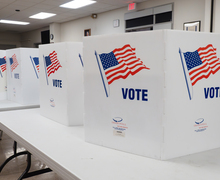Supreme Court should prioritize animal well-being before entertainment
On April 20, the Supreme Court of the United States reversed an existing federal law banning the creation and sale of dog-fighting videos and other depictions of animal cruelty. The court ruled 8-1 to overturn the law on the grounds that the First Amendment was infringed.
Despite the ruling, there is still a possibility for Congress to more specifically outlaw animal cruelty videos. Similar to the way child pornography is outlawed because of its immorality, dog fighting and ‘crush videos’ should be as well. Crush videos show small animals being tortured to death by women in bare feet or in high-heeled shoes. Although a very small portion of the population that takes pleasure in watching animals being violently abused, most people find such videos are obscene.
The law was based off this moral basis. It stated that a depiction ‘in which a living animal is intentionally maimed, mutilated, tortured, wounded or killed’ is illegal if the acts are illegal in the state in which it was filmed. The law made exceptions for ‘religious, political, scientific, educational, journalistic, historical or artistic value.’
This language, though, was found to be flawed by a majority of the court. Although there is a moral consensus rejecting the videos, the court ruled that the law enabled the government to restrict free expression. The majority decision, written by Chief Justice John Roberts, claimed that, ‘While the prohibition of animal cruelty has a long history in American law, there is no evidence of a similar tradition prohibiting depictions of such cruelty.’ Though animal cruelty may be illegal, videotaping it is legal.
Justice Samuel Alito had a different stance when he wrote the dissenting opinion. He claimed that the law was valuable because it criminalized a great portion of videos depicting animal cruelty. By doing so, the market for animal cruelty videos was weakened. Because of this, there was a decrease in animal cruelty overall. He also pointed out that it was hard to penalize the individuals depicted in the videos because their faces are rarely shown. By making the videos illegal, it would have a similar effect to penalizing the individuals.
A law needs to be passed banning the sale of crush videos and dog fighting. There has already been a law proposed to ban crush videos. The First Amendment was not designed to protect the interests of individuals who take pleasure out of watching as animals are killed by a woman in high heels. Nor was it created so that dog-fight videos could be produced.
Regardless of the abuse, there is an underlying issue of animals being used for our entertainment. Mohandas Gandhi’s famous observation on the issue was that ‘the greatness of a nation and its moral progress can be judged by the way its animals are treated.’
Exploiting animals for the purpose of entertainment reflects badly on the United States. Whether it is ‘sport’ hunting, greyhound racing, the circus or crush videos, there is no valid justification for this type of ‘entertainment.’ We might consider it fun to watch or do, but we rarely appreciate animals’ perspectives. They don’t matter to us.
Obviously, based on the number of individuals who enjoy watching this entertainment, others think animal entertainment is acceptable. This is why many, including Chief Justice Roberts, find that animal cruelty is not quite comparable to child pornography. The government is compelled to protect those subjected to child abuse. Unfortunately, the case is not the same with animals because we do not value them as much. Despite our objection to the videos, if we do not elevate our treatment of animals, there is no reason why the government will extensively protect them.
Harmen Rockler is an undeclared freshman in the College of Arts and Sciences. His column appears bi-weekly and he can be reached at horockle@syr.edu.
Published on April 26, 2010 at 12:00 pm





